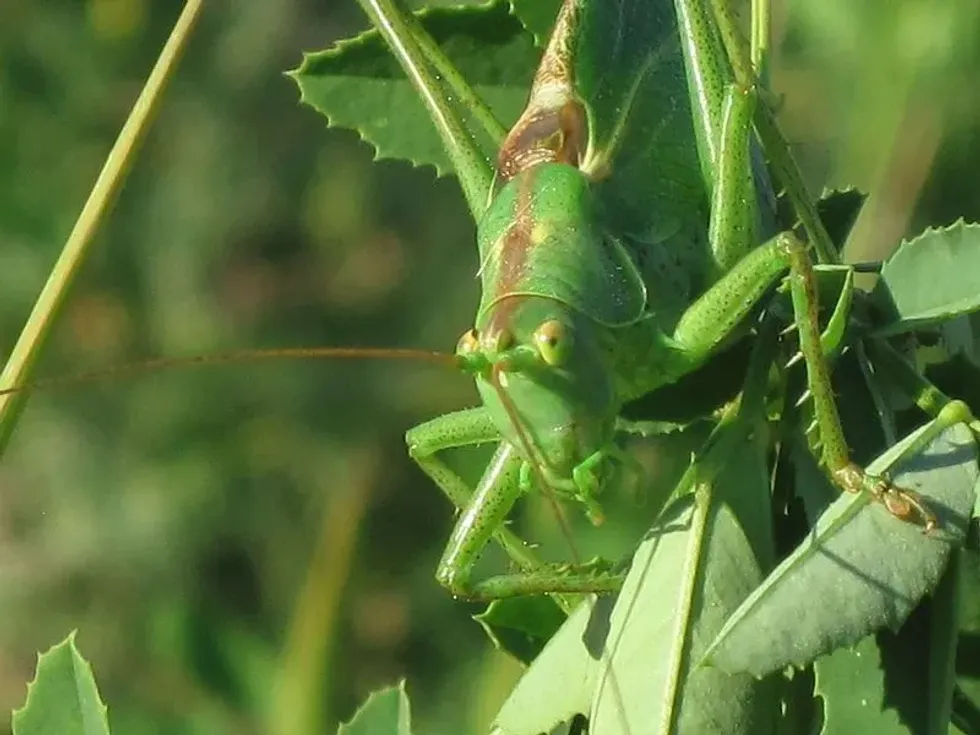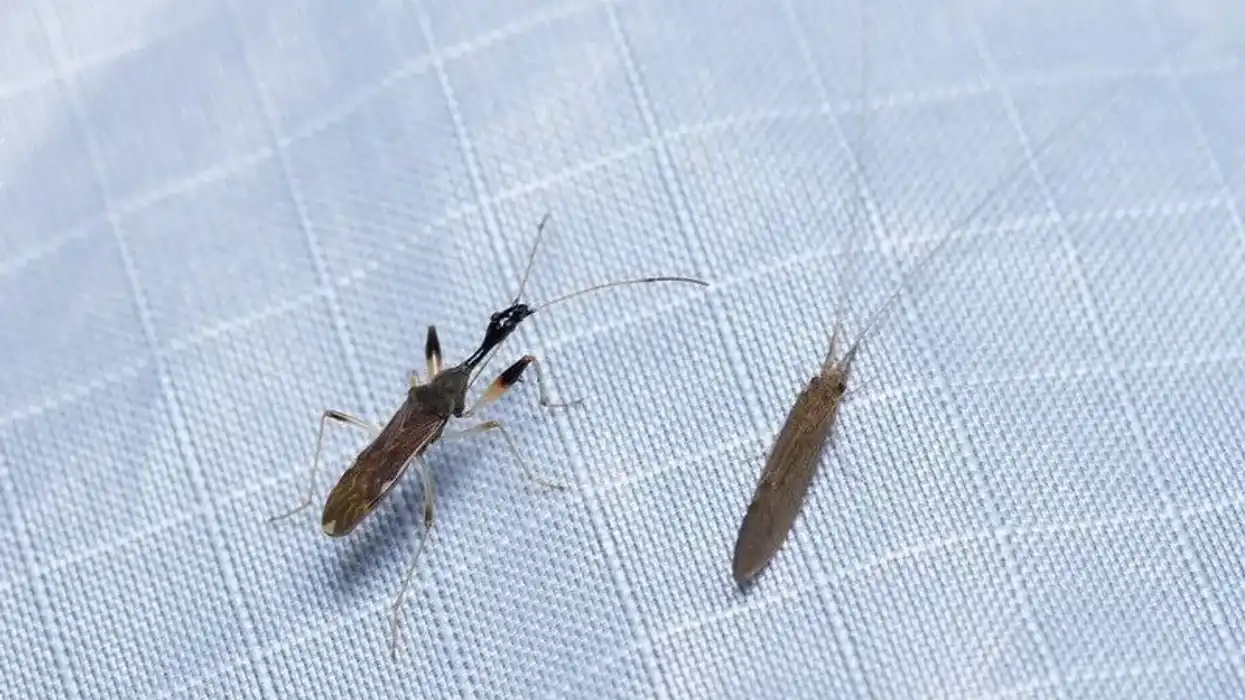Are you fascinated by crickets like mole crickets? Then here we have all the information on great green bush-crickets.
The great green bush-cricket (Tettigonia viridissima) is a species of katydid whose geographic range is pretty widespread. This insect is extremely beautiful with its long green body and long wings.
These wings help these insects fly far when they need to escape from predators. Females of these insects are usually longer than the males because they carry an ovipositor at the end of their bodies. Both sexes have a rust-brown line on the top of their dorsal side.
The stages that the eggs of these insects go through are some of the most interesting things about them. The eggs go through a diapause in the first winter, and this diapause can last for about two years or seven years, depending upon the environment.
Read on to know more about the great green bush-cricket, and if you like this article, then also check out the northern mole cricket and cricket insect.
Great Green Bush-Cricket Interesting Facts
What type of animal is a great green bush-cricket?
The great green bush-cricket (Tettigonia viridissima) is a species of katydid.
What class of animal does a great green bush-cricket belong to?
The great green bush-cricket belongs to the class Insecta of animals.
How many great green bush-crickets are there in the world?
The population of these insects in an exact number is not known. However, they are known to be pretty common and even abundant in some places.
Swarms of these insects could once be seen around parts of their habitat range, however they cannot be seen anymore. This has led to the belief that their population may have declined in the past in a great number.
However, their population trend is now on the rise again as they have been observed to be spreading to the Netherlands.
Where does a great green bush-cricket live?
The geographic distribution of the great green bush-cricket (Tettigonia viridissima) is pretty widespread. They can be found from western China and the Altai mountains to the European Atlantic coast.
In Europe, their east-to-west range has been observed to be from eastern European Russia to Portugal. Their north-to-south range has been observed to be from southern Finland to Crete, Spain, Cyprus, and Lampedusa.
What is a great green bush-cricket's habitat?
The preferred habitats of these insects are ditches, forest clearings or edges, dense vegetations or grasslands, farmlands, gardens, parks, and wetland habitats. The preferred habitats of a great green bush-cricket nymph are high and dense vegetations, while adults are mostly seen around houses, trees, or bushes.
Who do great green bush-crickets live with?
Katydids are usually solitary in nature. We can assume great green bush-crickets show similar behavior.
How long does a great green bush-cricket live?
The lifespan of these insects is about two to seven years.
How do they reproduce?
The breeding season of the great green bush-cricket (Tettigonia viridissima) occurs around the summer. The males can be heard singing during courtship behavior, and females respond in kind. The mating process can last about an hour or so.
After copulation, the female lays around 600 eggs. Nothing is known about the parental care done by the adult male or the female.
The eggs enter a stage known as diapause during the first winter. During this, the eggs become dormant for the first winter. When winter ends, they start to develop and become dormant again during the second winter.
The eggs hatch in the following April. It can also happen that the eggs go into diapause during the first winter and stay dormant for as long as seven years.
When the eggs finally hatch, the larvae go through seven stages before they become adults. The adult males and females repeat the cycle, reproduce in the next summer, and die during the fall.
What is their conservation status?
The conservation status of this species, according to the International Union for Conservation of Nature, is listed as Least Concern. Their population is on the increase, and they are not facing any great threats except the usage of pesticides, agricultural intensification, and urbanization.
Great Green Bush-Cricket Fun Facts
What do great green bush-crickets look like?
The great green bush-cricket (Tettigonia viridissima) is a large-sized katydid species. They also have long antennae and long wings. These insects have a long body that is usually entirely green in color.
Other than that, they have a line of brown rust color that can be seen at the top of the dorsal side of their body. Some insects among them have been seen to possess yellow legs.
A female of this species carries a long egg-laying ovipositor around the end of its body. This ovipositor can be about 1 in (3 cm) in length. Due to this length of the ovipositor, the females are usually longer than the males.
How cute are they?
These crickets are pretty gorgeous, but not everyone will find them cute. Many people are afraid of insects, whether they are harmful or not.
How do they communicate?
Great green bush-crickets communicate by sound. They have an acoustic organ on the knees of their forelegs and they use these to make a 'chirr' sound.
Their song is to attract partners. In addition, they have an organ that helps them feel the slightest of vibration and helps them escape before a predator arrives. They also have big eyes that help them see really well.
How big is a great green bush-cricket?
The great green bush-cricket size of 1-2.7 in (3-7 cm) is one of the largest among katydids. An adult male of this species grows up to about 1.4 in (3.6 cm) in length, and an adult female grows up to about 2.7 in (7 cm) in length.
They are slightly bigger than Jerusalem crickets, which are about 1.2-2 in (30-50 mm) in size.
How fast can a great green bush-cricket fly?
The exact speed at which these insects fly is not known. However, whenever they get the feeling of danger approaching, they can take a flight with the help of their long wings and travel 328 ft (100 m) at a time.
How much does a great green bush-cricket weigh?
Due to a lack of research, it's not known how much these insects weigh, just like the mole cricket. They are little insects, so it's hard to imagine that they are very heavy at all.
What are the male and female names of the species?
The males and the females of this species have no specific names.
What would you call a baby great green bush-cricket?
A baby great green bush-cricket (Tettigonia viridissima) is called a nymph.
What do they eat?
These insects are predatory in nature. Unlike other herbivore crickets, like Mormon crickets, these crickets and their carnivorous diet can be helpful for agricultural purposes. They feed on aphids, caterpillars, small insects, even sick insects of their own species.
Are they dangerous?
They are not dangerous at all. However, they pack a painful bite in their strong jaws. They won't bite unless they are threatened, so try not to handle them. Admiring them from a distance is the best option.
Would they make a good pet?
Most crickets, like camel crickets, make good pets. However, keep in mind that they require a very specific environment to survive, similar to their wild habitat.
Did you know...
Birds, frogs, bats, snakes, and other insect eaters prey on great green bush-crickets (Tettigonia viridissima).
These insects can be confused with grasshoppers or locusts. Locusts are a grasshopper species. These locusts or grasshoppers can be distinguished from these crickets by their antennae. All crickets have long antennae, whereas, grasshoppers or locusts have short ones.
How does a bush-cricket camouflage?
Bush-crickets, like great green bush-crickets (Tettigonia viridissima), are green in color, so they blend easily with plants. This helps them camouflage.
How many eggs do great green bush-crickets lay?
A female great green bush-cricket lays about 600 eggs.
Here at Kidadl, we have carefully created lots of interesting family-friendly animal facts for everyone to discover! Learn more about some other arthropods from our jewel beetle facts or wood tick fun facts pages.
You can even occupy yourself at home by coloring in one of our free printable cricket in a cage coloring pages.










